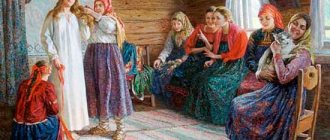The Caucasus... How many people have only heard about its beauties! And yet, anyone who has not been there in person cannot express in words how perfect it is. Amazing landscapes, clear mountain rivers, green valleys full of abundance and starry skies overhead.
And this wonderful world could not have survived to this day if it were not for the people who care about it. Those who care about the condition of their home.
Avar wedding traditions
The Avars are a people who are famous not only for their valor and honor, but also for their attitude to the traditions and customs of their ancestors.
From ancient times to the present day they have been revered and tried to follow them in everything. This is especially true for weddings and family life. It has long been a custom that only parents choose a bride for an Avar guy. Marriages were concluded exclusively by prior agreement between elders and remained strong until the end of the spouses' lives . An Avar wedding is the result of an agreement between relatives and unquestioning submission to the parental will. The Avars are a small people, and in order to preserve them, it was customary to marry guys only to Avars, choosing brides after carefully familiarizing themselves with their families.
How does matchmaking and engagement work?
In former times, it happened that the bride and groom met for the first time only at their own wedding, although from childhood they knew that their husband or wife had long been chosen by their parents.
The dowry for the bride was also collected from the moment of her birth, because the main purpose of a woman is to become a submissive wife, a good housewife, and a caring mother.
Today, a guy chooses his own bride, but he is unlikely to be able to make a decision and get married without his father’s consent. If the father and mother agree with their son’s choice, they make inquiries about the position of the girl’s family members in society, their material well-being and level of education. Having approved the bride's candidacy, they meticulously select those who will become matchmakers.
To begin with, the guy goes to visit and, as a hint that he likes the girl, leaves some thing belonging to him in her parents’ house.
If the girl gives her consent, then matchmakers are sent to her father’s house, whose roles are the groom’s mother and sister. They can conduct so-called preliminary negotiations, but the final decision will be made by the young man’s father. On the day when men representing the boy’s family appeared on the threshold of the girl’s parents’ home, the ceremony of “choosing a groom” was carried out.
Most often, the young man's brother with his uncle, friends and older men brought gifts to the house of the future bride.
Matchmaking among the Avars is more like a small wedding. It takes place at a table laden with a variety of dishes, but before the conversation begins, musicians come to the house of the bride’s parents, as required by ancient rituals. These are three guys who are given three hats, three pairs of socks and three scarves.
Then men from the groom’s clan appear on the threshold and present their gifts. First of all, they offer food and sweet wine. As required by wedding custom, chicken and sweets are brought as a treat.
Matchmakers colorfully describe the young man’s virtues, praise his character, and list qualities such as courage, strength, and responsibility. They try to convince the bride's parents that the groom is capable of supporting his family and taking care of his wife and children. It is impossible to make a mistake in choosing a groom, since the Avars do not get divorced.
If an agreement is reached and a wedding day is set, the groom gives the bride jewelry, money and puts a gold or silver ring on her finger. From this moment on, the girl’s fate is practically sealed.
DAGESTAN WEDDING. EVERYBODY DANCE!
As Aminat said, gone are the days when a Dagestan bride and dowry rode to the groom’s house on a donkey. The dowry was simple, so he often had enough space on the donkey’s back: a large basin for bathing (required), a jug (required), and then a carpet, pillows, blankets, kitchen utensils (depending on the income of the “young”’s parents). Aminat herself (she is nearly sixty) no longer observed such a picture; in her memory, the donkey had already been replaced by an UAZ, and other traditions were transformed in accordance with the changing times, and some - after the donkey and the jug - disappeared altogether. However, as I was able to see after attending a Dagestan wedding, it is here that the national spirit of one of the most important celebrations in a person’s life is very, very noticeable. And that's great!
WITH
the wedding to which I was invited was played “from the groom’s side” - in Derbent. Before this, we “walked” in Kizlyar, where the bride is from. In general, the order of a Dagestan wedding is as follows: first the ceremony in the mosque, then the registry office, then the celebration at the bride’s, and about a week later at the groom’s. Our newlyweds were also about to have a third wedding - in Moscow.
It's time to finally introduce them: Timur and Adeline. Both he and she are natives of Dagestan, but the future spouses met in Moscow. Timur grew up in the capital (his parents moved here a long time ago), studied at the capital’s university, and works successfully. Adelina graduates from the Law Academy in Moscow.
Not all of their Moscow friends were able to fly to Dagestan for the main weddings, which is why the third one took place - in addition to the “program”.
Well what can I say? The wedding in Derbent was gorgeous: a luxurious banquet hall, luxurious “tables”, toastmaster, musicians, singers, dance groups, stage effects... This, by the way, is a relatively new tradition: parents begin saving money for their child’s wedding almost from the day of his birth and When the time comes, they give it their all.
I can’t say that such chic and shine contributes to the serious attitude of young people towards marriage, but the divorce rate in Dagestan is significantly lower than in other regions of the country. However, this has always been the case. Here, of course, a significant role is also played by a sense of duty to parents and respect for them.
Timur, for example, said words of gratitude to his parents with such strength and sincerity that it was impossible not to be moved. He spoke, of course, not about what troubles and money this celebration cost them, but about those important human qualities that his father and mother raised in him. However, Timur, of course, also understood everything about the “means”.
There were about 600 guests - relatives, friends, neighbors... Not the most crowded (!) wedding by Dagestan standards. Among the guests I was the only woman in trousers. This confused me, but the host of the wedding, Azim Davydov (a television and radio presenter from Makhachkala - that’s how he introduced himself) reassured me: “Everything is fine, don’t worry.”
I noticed that the local guests, women and men, were seated at different tables. At mine, too, only the fair sex and children sat. I didn’t keep track of how things were at the “men’s” tables, but on mine, which was uncorked (at my request), there was only one bottle of champagne, although the alcohol was presented, as they say, in an assortment. They don't drink in Dagestan. Or they drink very moderately. Even at weddings. Women don't drink at all. These are my observations. But that didn’t stop the fun!
Guests were greeted at the entrance to the hall by the parents and aunts of the groom (I say “groom” and “bride” out of habit, although Timur and Adelina, after the mosque, the registry office and the wedding in Kizlyar, of course, had already assumed the rights of spouses).
One of the aunts is the same Aminat who told me about ancient wedding traditions. Imagine, before, a guy could throw his hat at a girl’s window and wait with trembling hearts whether the headdress would fly back with a whistle or not. In the first case, this meant turning away from the gate, in the second - “I love you too, send matchmakers.”
This is how it was, and not all bride kidnapping, as many people think about Caucasians. They were kidnapped when parents did not give the go-ahead, and feelings were raging. They say this still happens, but very, very rarely.
.
...As the experienced toastmaster Azim told me, the main wedding traditions preserved by all the peoples of Dagestan are the dance of the bride and groom, welcoming words from parents and close relatives, “sweet pilaf” in the middle of the celebration - as a symbol of a future happy life, but the main thing is the sound all evening national music and national dances performed to it.
The most incendiary are among the Avars and Kumyks. Our wedding was a Dargin wedding, and the Dargins, as Azim put it, have dances of “average rhythm.” Well... I don’t know, you need to attend an Avar wedding and compare.
Lezginka was wow! Now I understand why most Dagestani men are lean and even thin: large families, weddings one after another, and “everyone dances!”
Lezginka is a very energetic dance. In a male version. He was the very first at the celebration: the beautiful bride walked in a circle as a peahen, bowing her head and gracefully moving her hands, and horsemen circled around her one by one - asses! At the same time, banknotes were flying thickly into the “circle” from the guests, which were collected by the bridesmaids. Tradition!
But the next one was a dance of young people, also a Lezginka, and Timur danced in a burka and a hat (probably the one that Adelina did not throw out of the Moscow window).
Throughout the evening, several more times the young guys rocked this kind of “competitive” lezginka. It was danced by the groom's parents, the bride's parents, and brave men circled around the ancient grandmothers...
By the way, one such elderly relative gave parting words to the young ones in Dargin - she was the only one who congratulated. As the same Azim said, the main language at Dagestan weddings is Russian, which is understandable in a multinational republic, Russian unites everyone here. But speeches by the most respected, the oldest in their native languages are definitely the highlight of such celebrations.
And finally, about the new wedding tradition, the emergence of which was noted by Aminat. Now, she shared, everyone wants to show the guests something new that they, the guests, definitely haven’t seen at other weddings. On our, “Derbent”, such a highlight was a romantic film about young people, about their acquaintance, about their love.
Whatever you say, the tradition is difficult to implement. However, the competitive spirit characteristic of Dagestanis can work wonders! But that’s okay, traditions come and go, only the most necessary remain. The main thing is that Timur and Adelina, who were leaving the wedding in a sparkling elegant Mercedes under the multi-colored fireworks that lit up the evening sky of Derbent, were happy. Such a beautiful couple!..
Marina BOYKOVA
Category: Around the world -> Autogeography
Tags: around the world | autogeography | travel | traditions | Derbent | wedding
Leave a comment!
To leave a comment, register
or
log in
through your account.
Wedding preparations
Preparations for a wedding can last from a year to two or three years. It all depends on the level of financial status of the young parents. Despite the fact that a dowry for a girl begins to be prepared from the day of her birth, only after the engagement the women in the bride’s house begin to sew wedding dresses.
In the mountains of Dagestan, it is customary to prepare thoroughly for a wedding. The bride's dowry includes everything necessary for life:
- pillows and blankets;
- bed and underwear;
- cloth;
- shoes;
- kitchenware.
Of course, in cities, a girl receives more than just a bed as a dowry. Household appliances and electronics are prepared here.
To prepare for the upcoming wedding, the relatives of the bride and groom need to take care of food supplies. After all, the holiday will take place in both houses.
Features of a modern wedding in Dagestan
At the request of the couple and their relatives, the wedding can be modest, according to Muslim customs, without alcohol and with separate tables for men and women. Or the usual one, noisy, with fun, dancing, music and a hearty feast. They usually celebrate either in the banquet halls of restaurants or in the courtyards of houses. The main requirement for the venue of the feast is that it must accommodate everyone.
Registration at the registry office is carried out during the second day of the celebration. Since the number of guests is prohibitive, preparing for wedding celebrations is a very responsible matter. Even just choosing a menu so that there is enough for everyone and the guests are satisfied is quite a difficult task. But there is, in fact, a double wedding, doubling the costs and preparation problems!
Celebration
Among the Avars living in a village in the mountains, it is customary to invite all residents of the village to the wedding. This is a real feast that will last for several days.
On the first day, the groom celebrates with his friends, and the bride is with her friends and older women, who dress her up and introduce her to relatives. At the first stage of the holiday, the bride's father visits the house of the groom's parents, where he is treated and given gifts.
Then it is the groom’s turn, who, together with his brothers and friends, brings gifts to the bride’s house. All gifts brought are put on public display so that neighbors can be convinced of the groom’s wealth and assess his level of wealth.
After the wedding
On the third day after the celebrations are completed, the bride leaves the room and, accompanied by her friends, goes to the well to draw water.
In addition to the jug, she should have a large amount of sweets with her. She will use them to pay off her friends who will try to prevent her from filling the jug with water.
Despite the fact that, according to tradition, the newlyweds will live in different rooms and will not have close contact, it is the young wife (submitting to her mother-in-law in everything) who will be responsible for the economic part of their life and much will be impossible to do without her consent.
In this video there is an Avar wedding with national traditions and customs:
The main feature of an Avar wedding is the organization and holding of the holiday in accordance with ancient customs and traditions. Many representatives of this people no longer live in mountain villages, but in large cities, but even here weddings are held in such a way as not to offend the memory of their ancestors and not to lose face in front of relatives and neighbors. How to observe traditions when organizing a city wedding of an Avar? Who will be invited? Where to celebrate a special event? Opinions and advice from a variety of people will help young people make this significant day unforgettable.
Customs and traditions at a modern Tatar wedding
The desire to have a wedding, observing the rituals and traditions of one’s people, will fill an important event in the life of a couple in love with bright color and ethnic identity.
For a Muslim young family, performing a wedding ceremony following the unwritten laws of their ancestors, touching with all their hearts the rich cultural heritage, is considered an excellent start to life together. A Tatar wedding is a wedding celebration of amazing beauty and unique national performance. By organizing a holiday in this way, a young couple announces to everyone about the strength of their marriage.
Traditions of celebrating an Avar wedding
An Avar wedding is a magnificent event that is traditionally celebrated by the Dagestan people. He managed to preserve the traditions of his ancestors practically unchanged. Thanks to this, weddings have become a local attraction. Wedding traditions and rituals are of great importance for the Avar people. Moreover, they have a significant impact not only on the bride and groom, but also on the invited guests.
The wedding is celebrated magnificently, and the entire population of the village is invited to the event. Because of this, a large number of people usually participate in wedding ceremonies and rituals. Which symbolizes the unity and readiness of the people to be close at all times.
If you get the opportunity, it’s worth visiting this noisy and vibrant event at least once. An invited toastmaster helps the newlyweds with the celebration. In a number of regions of Dagestan he may be called the word “Shah”. Traditionally, a close relative or friend acts as the toastmaster. He leads the entire event and ensures that traditions are followed. His work is very valuable and voluminous, since a wedding can last more than one day.
Matchmaking and stages of negotiations
An important tradition in Dagestan is the wedding ceremony by prior agreement. The essence of the ceremony comes down to introducing the young parents. This is allowed even if the couple did not know each other before the wedding in principle. According to statistics, most families in Dagestan were created according to this principle. And the couple's first meeting was scheduled for the wedding day.
For many people brought up in European traditions, such customs may seem wild. But according to observations, it is precisely such rituals that make families in the country truly strong. Trust and respect for the opinions of parents does its job, while many Western cultures have lost such a concept.
A special part of the wedding event is often the payment of bride price to the bride. This is a kind of ransom, the amount of which is established by agreement between the families. It is discussed by matchmakers, but in any case must be formalized with the help of a priest. According to the laws of the Koran, the bride price is paid to the young bride as a symbol of a guarantee of a strong marriage. But recently, more and more men are giving it to the girl’s parents as a kind of ransom.
Nuances and traditions of choosing a bride
Parents carefully select a bride for their son. Relatives and friends often took part in the search for a spouse. Factors such as hard work, health and level of social adaptation in society were taken into account.
According to local traditions, the main role of the wife is to competently manage the household. She must be able to receive guests with dignity and also have good health. This is important not only for maintaining comfort, but also for the birth of future healthy offspring. Factors such as the girl’s origin also played a role. Therefore, she was usually chosen from her own class or someone close to it in status.
How to choose
Parents are extremely careful when choosing a future bride or groom for their child. Close relatives also took part in this, and when searching for a girl, they primarily took into account her hard work, restraint, good manners and health. After all, by their definition, a wife must not only be an excellent housewife, capable of keeping it clean and always properly receiving guests, but also strong enough to bring healthy children, future heirs, into the world. Of course, her origin was also taken into account, so they usually looked for her among her class.
Traditions of the stages of matchmaking and engagement
A wedding in Dagestan is traditionally held in several main stages. The first of them takes place in the girl’s house, the second in the groom’s house. But before this stage, traditional matchmaking is certainly carried out, which has its own interesting national characteristics. To conduct it, the groom's family invites the girl's father to their house. After his consent and visit, the father will be treated and cajoled in every possible way until he agrees to give his daughter in marriage.
After the father's consent, the groom had the right to visit the house of his future wife with traditional fun and treats. Their value played an important role, since on the wedding day, a man’s gifts were often displayed as family property for everyone to see.
Farewell to parents
And, of course, like any important celebration, the Avar wedding was magnificent and fun and required lengthy preparation. Almost all the women of the village are involved in this, because it is impossible to stock up on food for so many guests, and therefore everyone starts cooking a few days in advance. However, even if an Avar wedding in the mountains is fun, noise and joy, its final stage - bringing the bride into the groom's house - is the culmination and saddest moment of the entire holiday. As the newlyweds take their steps, they are showered with candies and coins so that their further journey will be sweet and comfortable. And this peak means that the girl leaves her parents’ house forever and moves into her husband’s family.
Stage of the wedding ceremony
For that part of the people who live in villages and hamlets, it was customary to invite the entire settlement to the wedding. This is an event that is accompanied by fun and abundant feasting.
On the first day of the ceremony, the groom celebrates separately with the young people. While the bride is with her friends and older women. Their task is to dress the girl and introduce her to her relatives. A visit to the groom's home by the bride's father is also planned. There he should also be treated and generously given various gifts.
Then the groom, together with his relatives and friends, visits the house of his betrothed with gifts and plentiful treats. There is a tradition in which the groom's gifts are displayed for public viewing by the bride's relatives. This is done for public recognition and assessment of the level of well-being of the future spouse and head of the family. During this period of celebration, a special religious ceremony is held, at which the presence of the young bride is not necessary.
The bride usually celebrates her wedding separately from her husband, surrounded by older women and friends. Farewell to parents takes place on the 3rd day of the celebration.
According to tradition, a man must take his betrothed to his home on the second day of the celebration. This moment is considered the saddest and culminating. She should appear in front of the guests in finery, but cover herself with a blanket. On the threshold of a new house, the girl should be met by women of the male clan along with her mother-in-law. The latter should smear the lips of the young bride with honey, as a symbol of the sweet life in the new family. The rest of the girls should let the bride hold the child, ideally male.
An ancient popular belief says that only after such a ritual a couple will definitely have a son. And men, as you know, enjoy much greater advantages among peoples of this type.
All young people are prohibited from entering the bride's room. The groom himself comes to the girl late at night. In the morning hours, she is congratulated on her wedding night by the women in the house. She is also given gifts and treats, accepting her husband into the new clan and family.
Next comes a stage that may be incomprehensible to European women. In its process, a man celebrates his wedding with friends and men, while the bride waits for him at home. At the same time, traditions and customs do not allow the bride to even leave her room.
Features of the culture of the Dagestan people
Dagestan has very strong traditions of hospitality. A set of rules that has existed for centuries prescribes hosts to be kind and attentive to guests. The homes of Dagestanis are always open to dear relatives, neighbors, and friends. Even a stranger who accidentally finds himself in the village is accepted as his own relative.
Children and youth are taught to listen to and honor their elders, respect their parents and protect their clan and family.
Despite the influence of Islam, adopted by the inhabitants of Dagestan since the rule of the Turks and Persians, women here have a special, caring attitude. Some researchers believe that initially matriarchy reigned in local tribes. The emphatically respectful, even naming in the third person, attitude of the wife towards her husband is adjacent to the prohibition for the weaker sex to engage in heavy physical labor. The polite wisdom of women can always cool the hot heads of male arguers. Also, in Dagestan it was not customary to wear a veil; on the contrary, girls and women dressed brightly, with numerous head decorations.
A wedding in Dagestan is not just a union of two loving hearts, it is an occasion for all relatives and friends to gather for a celebration of stunning scope. During this period, two separate families merge into a single whole. New relatives actively get to know each other and communicate. In the old days, local villages lived from wedding to wedding. All the surrounding villages gathered for this significant event, and guests came from remote areas. The wedding was celebrated in several stages, and the preparatory period began with the birth of children.
Traditions and customs after the wedding
On the 3rd day after the main celebration, the bride, accompanied by her friends and older women in her husband’s family, goes to the well to draw water. Along with the jug, the girl must take with her a certain amount of sweet treats. The ritual is for the bridesmaids to prevent the bride from drawing water. She, in turn, must recoup from them with the help of sweets.
According to local traditions, after the wedding, the couple will live separately from each other, and close contact occurs extremely rarely. Despite this, the girl often participates in running the household of a new family under the auspices of her mother-in-law. Much in the house cannot be done without her permission.
An Avar wedding is a combination of ancient traditions and modernity, which give the celebration zest and national flavor.











